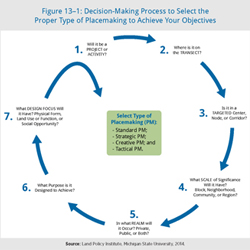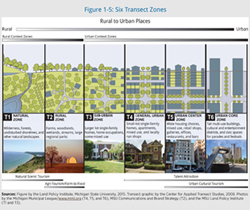What is your type?
There are four types of placemaking (Standard, Strategic, Tactical, and Creative) defined in the guidebook on Placemaking as an Economic Development Tool, published in January by the MSU Land Policy Institute and the MIplaceTM Partnership Initiative.

There are four types of placemaking (Standard, Strategic, Tactical, and Creative) defined in the guidebook on Placemaking as an Economic Development Tool, published in January by the MSU Land Policy Institute and the MIplaceTM Partnership Initiative. Each type has unique assets that make them a special fit for various communities or projects, and when combined together creates the complete placemaking package.
Standard Placemaking is the universal term for what we know to be “placemaking,” and often refers to the type of placemaking that is advanced and promoted by the Project for Public Spaces. The other three varieties of specialized placemaking have evolved, over time, to achieve a particular purpose in a community. Tactical Placemaking, as advocated by the Tactical Urbanism team, is the process of creating quality places using a deliberate phased approach that can occur quickly and often at a low cost. Strategic Placemaking, as advocated by the MIplace™ Partnership Initiative, specifically targets knowledge workers in order to create a quality place that attracts talent, so that it can create substantial job and income growth by attracting businesses. Creative Placemaking, as advocated by the National Endowment for the Arts and others, is a specialized form of placemaking that utilizes arts and culture projects, and activities, to inject new life into public spaces, and improve the physical and social character of the community.
 If properly applied, all four types of placemaking can improve the quality of life in a community. Additionally, these types are not mutually exclusive and can be used separately or in combination with each other. They can also be implemented sequentially in order to maximize the usage of volunteers and funding, so that they can be tailored in a way that is best suited to what the user is trying to accomplish. In order to first decide which type of placemaking should be used in a community it is important to weigh the strengths and weaknesses of the four types in order to decide which one best suits your needs. To start, it is necessary to address the question “What do you want to achieve, and by when” before going through a series of decisions to help you narrow which type (or types) of placemaking should be used. These questions and steps are illustrated in Figure 13-1 from the Placemaking Guidebook.
If properly applied, all four types of placemaking can improve the quality of life in a community. Additionally, these types are not mutually exclusive and can be used separately or in combination with each other. They can also be implemented sequentially in order to maximize the usage of volunteers and funding, so that they can be tailored in a way that is best suited to what the user is trying to accomplish. In order to first decide which type of placemaking should be used in a community it is important to weigh the strengths and weaknesses of the four types in order to decide which one best suits your needs. To start, it is necessary to address the question “What do you want to achieve, and by when” before going through a series of decisions to help you narrow which type (or types) of placemaking should be used. These questions and steps are illustrated in Figure 13-1 from the Placemaking Guidebook.
 Once these questions are answered the community will have a better understanding what type of project would be best suited for the task at hand. It is important to remember that the strategies can be implemented in sequence, or even simultaneously if there are enough resources and volunteers behind the effort. Acknowledging where your community lies on the transect (see Figure 1-5) is important when deciding what placemaking type to use as well, since something that may make sense in a T3-T6 zone may not be as applicable in a T1-T2 zone.
Once these questions are answered the community will have a better understanding what type of project would be best suited for the task at hand. It is important to remember that the strategies can be implemented in sequence, or even simultaneously if there are enough resources and volunteers behind the effort. Acknowledging where your community lies on the transect (see Figure 1-5) is important when deciding what placemaking type to use as well, since something that may make sense in a T3-T6 zone may not be as applicable in a T1-T2 zone.
All forms of successful placemaking depend on broad engagement of stakeholders in the design of the projects and activities that follow. However, it is up to the user and project leaders to first decide which type(s) of placemaking their community needs.
To learn more, order your free copy today at: Placemaking Guidebook.



 Print
Print Email
Email



